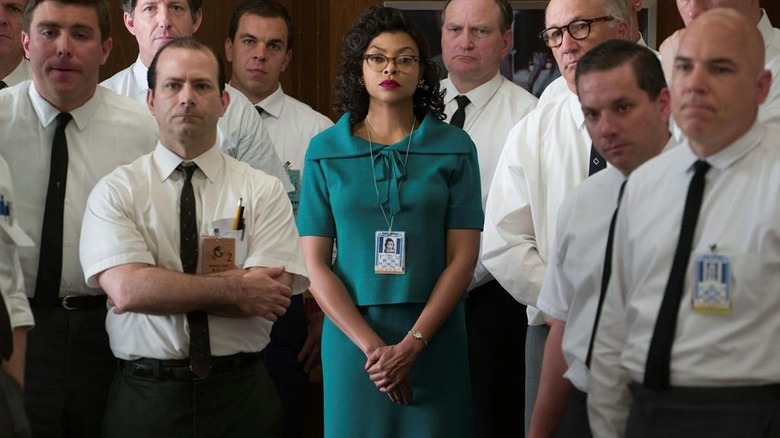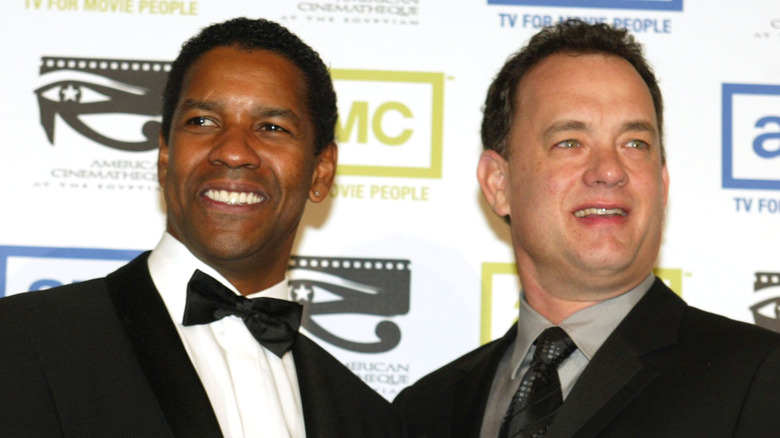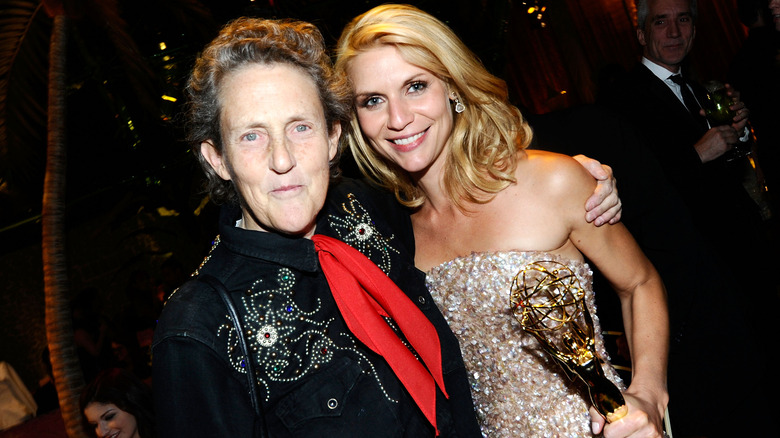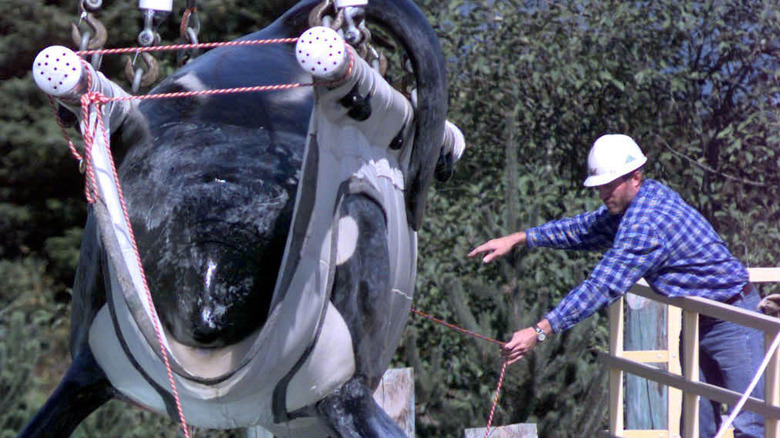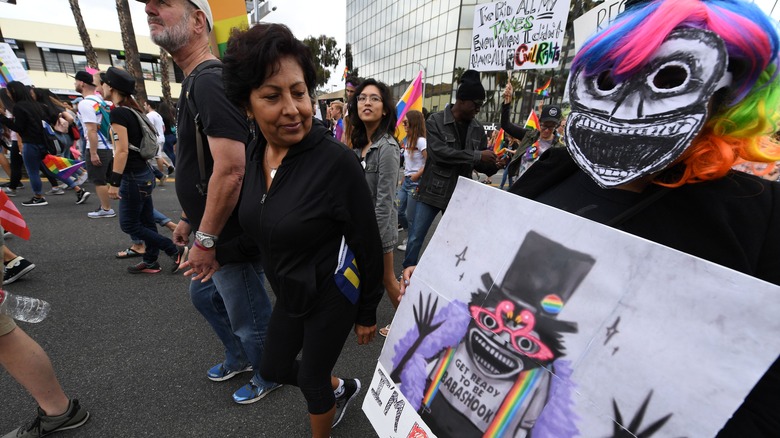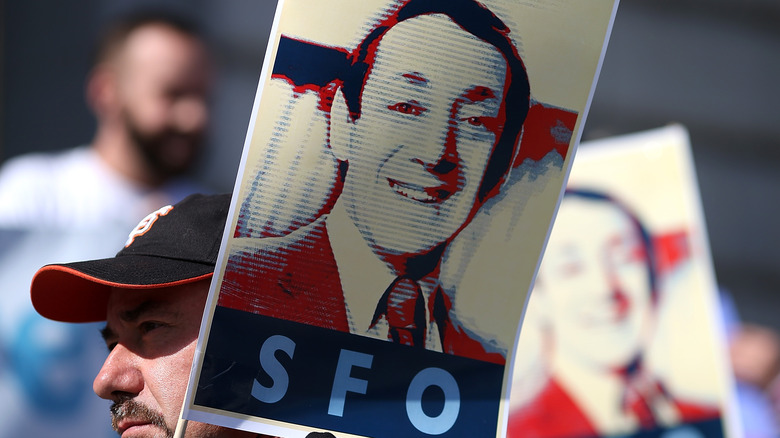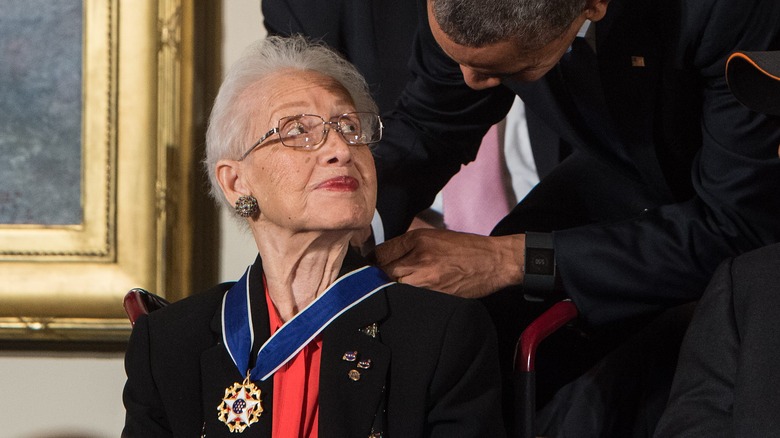Movies That Have Inspired Good Things To Happen
Movies can provide a lot of amazing things, even beyond the opportunity to buy a head-size container of buttery popcorn and laugh at a woman getting diarrhea in an expensive wedding dress. The movies on this list all had a meaningful impact on the real world, like social change, increased awareness of important issues, the honoring of forgotten heroes, and even the proliferation of hilarious and important memes.
The Day After Tomorrow made people care more about climate change
The Day After Tomorrow didn't necessarily convince audiences that it was a good movie, but it did convince them to pay attention to climate change. The 2004 Roland Emmerich film stars Dennis Quaid as a climate scientist who has to save his son from a crazy, climate change-induced storm that brings on a new Ice Age. It only has a 45 percent on Rotten Tomatoes with many critics finding it ridiculous and cliché, but it was hugely popular, making almost half a billion dollars.
According to a study by Yale researchers, the movie "had a significant impact on the climate change risk perceptions, conceptual models, behavioral intentions, policy priorities, and even voting intentions of moviegoers." Basically, the movie stuck with people. It made them care more about climate change, to think more about how their actions affect the environment, and even to vote for candidates whose views aligned with their heightened concerns.
This impact didn't, however, extend to New Yorker film critic Anthony Lane, who called it "irretrievably poor: a shambles of dud writing and dramatic inconsequence which left me determined to double my consumption of fossil fuels."
Philadelphia helped reduce the stigma of AIDS
Philadelphia, the 1993 film about the HIV/AIDS epidemic, presented its topic in a new way for many people. According to Columbia professor Rita Charon, whose organization honored the movie for its impact in 2013, it was "one of the first mainstream movies to address HIV/AIDS, homophobia, and discrimination."
The film stars Tom Hanks as a successful corporate attorney who is fired after contracting AIDS. Denzel Washington plays his homophobic lawyer, who ultimately gains empathy for Hanks' character after spending time with him and his partner and helping him fight for his rights. Jodie Howard of Cinema of Change notes that casting Hanks, an extremely popular heterosexual actor, in the role of a gay man with AIDS helped prejudiced audience members relate to the character. Howard notes that at the time of the film's release, many people, including powerful public figures, looked down on people with the disease and didn't understand it.
The movie won two Oscars and introduced and explained the issues at the core of the HIV/AIDS epidemic of the time, which helped reduce discrimination, hostility, stigma, and incorrect views about the illness and about gay people.
Temple Grandin raised awareness about autism
In 2010, HBO made a movie about Temple Grandin, a scientist with autism who studied animals, helped develop animal welfare guidelines, and became a champion of children with autism. Temple Grandin was nominated for 15 Emmys that year and Claire Danes won an Emmy for her portrayal of the scientist. But it wasn't just the star-studded, prestigious biopic that brought further attention to this gifted scientist and woman with autism. It was also the amazing presence of Grandin herself at the 2010 Emmy Award ceremony.
Throughout the night, Grandin repeatedly stood up and clapped, rocked an awesome cowboy-inspired black and red pant suit, and thanked her mother who helped her as a child when she wasn't able to speak. ABC News named Grandin "Person of the Week" after the ceremony thanks to her memorable appearances, and the movie as well as the ceremony brought even more attention to the sensitivity of animals and the unique neurological processes of people with autism.
Okja made people want to save animals
Okja is a 2017 sci-fi movie that you might recognize from its Netflix thumbnail image of a gigantic pig creature. It's about a genetically modified animal that's made to be huge for, you know, meat. After a young girl raises and grows to love the animal, she fights to save Okja from being taken back by the corporation that created her.
In order to film a grisly, graphic, slaughterhouse scene, the film's director Bong Joon Ho visited a real slaughterhouse in Colorado. What he witnessed was so disturbing that he became temporarily vegan, telling IndieWire that he felt the smell was following him, and has said he is now transitioning into a pescatarian lifestyle. Many viewers of the film have also decided to become vegetarian, as you can see by searching "okja vegetarian" on Twitter and scrolling through the many dramatic declarations of newfound empathy for animalkind.
Free Willy led to the actual release of the starring whale
Free Willy is a classic childhood film for many. The 1993 kids movie was a popular sleepover screening pick for millennials. It focused on a little boy who frees a killer whale who is in danger of being killed by aquarium owners.
After the film came out and rose to popularity, however, people discovered that the whale who starred in the movie as the titular Willy was actually not free. The real whale, Keiko, was in an aquarium in Mexico City and was not doing well. In an expensive initiative, Keiko was rehabilitated in Oregon and then airlifted to Iceland, where trainers taught him how to live in the wild.
After being released in Iceland, he ultimately swam to Norway where he could have the human interaction he was used to. He ended up living out his life in the Norweigan Taknes Bay, where according to NBC, keepers fed him but he was free to roam. Keiko lived in this version of the wild with human care and affection until he passed away from pneumonia at age 27.
The Babadook became a symbol of gay pride
The way that The Babadook became a symbol of gay pride in 2017 may have been an accident. The Australian horror movie about a creepy monstrous figure from a children's book who haunts a mother and son was categorized by Netflix as an LGBT movie, or at least it looks that way from a possibly doctored image that appeared on Tumblr. People on the site ran with it, and started making jokes on social media about how the Babadook fits in with gay culture.
Some people think that this joke caught on because the Babadook is a logical allegory for queerness. As explored in Rolling Stone, the Babadook "represents queerness itself, an invisible threat made real through denial and oppression." According to Vox, "Mister Babadook, as the figure is referred to in the movie, is queer in the most empirical sense. Its existence is defiance, and it seeks to break down the borders of acceptability and establishment." Slate links the popularity more to the queer tradition of camp, or "viewing the 'wrong' details and nuances of a given cultural object as more pleasing than the ones the creator meant to foreground."
The monster is clearly meant to be a metaphor for a mother's grief and depression, but it's gained an exciting new life years after the movie's release as a symbol of gay pride. Whatever the reason for the Babadook's aptness and popularity in queer culture, the figure added a lot of laughter, delight, and community to this year's Pride festivities, including through people dressing up as Mister Babadook at pride parades.
Milk led to a campaign for gay rights
In 2008, screenwriter Dustin Lance Black's movie Milk was released. The film told the story of gay rights pioneer Harvey Milk, one of the first openly gay public officials in the United States, who was assassinated in 1978. Black went on to win the Best Original Screenplay Oscar that year, and Sean Penn won the Best Actor Oscar for his portrayal of Milk.
At the same time in the U.S., gay rights were under attack with California's passing of the restrictive Proposition 8 banning gay marriage. Black capitalized on publicity from his film to start an initiative for gay rights. He called on the government to affirm "the civil rights of gay, lesbian, bisexual and transgender citizens in all areas, including civil marriage, military service, adoption, Social Security, taxation, immigration, employment, housing and access to health care, social services, and education." Prop 8 was eventually overturned, and Black went on to create more artistic work promoting gay rights, including the play 8 and the miniseries When We Rise.
Hidden Figures led to a facility honoring the woman on which it was based
The 2016 film Hidden Figures told the true story of African American women at NASA known as "super computers" who calculated trajectories for America's first space flights in the 1960s. Hidden Figures was nominated for three Oscars and brought attention to Katherine Johnson, the protagonist of the film and real-life woman who astronaut John Glenn relied on to double check computer calculations before he went into space. According to NASA, Glenn asked engineers to "get the girl" to repeat automated math by hand to make sure it was correct before he would trust it.
After the film was released, NASA announced it would be naming a building at its Langley Research Center after Johnson. The Katherine G. Johnson Computational Facility is a $23-million, 37,000-square-foot facility that houses powerful computers used for "modeling and simulation, big data and analysis." Langley Director David Bowles said the opening of the building would "honor the legacy of one of the most admired and inspirational people ever associated with NASA."
Johnson got to attend the opening and was even presented with the Presidential Medal of Freedom by President Barack Obama. Both those things and she got to see Taraji P. Henson play her in a movie, which was probably pretty cool too.
